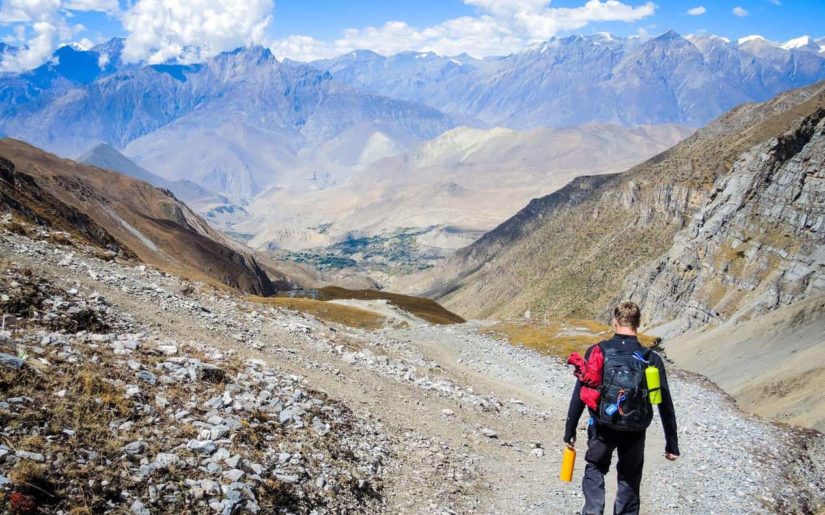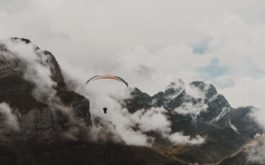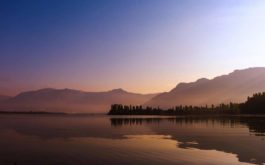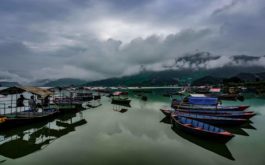In your adventure travel, the adventure will often be in the travel, not the adventure.
Yup! I composed that sentence exactly like I wanted to. Not clear yet? Let’s try it like this. In your adventure travel, the adventure is not in the adventure, but in the travel.
That says the same thing, just in a different way. See what authors can do? Not impressed yet? Here, let me drop the elegant repetition and use different words to explain the same point:
Yesterday I was just trying to go to the bank and ended up buying the world’s most obnoxious goat.
The wonderland of Nepal
Nepal is a wonderland.
Bordering on Tibet and China and India, the country rests on top of the world; eight of the world’s fourteen tallest mountains are here. On a clear day, most of them would be visible from the windows of this bus, rolling through the nation’s central valley.
Today is not a clear day. Most of the riders on the bus are soaked to the skin, their traditional clothing clinging to their robust and hearty bodies. I’m transfixed by the variety of both culture and morphologies on display; the mountains really do create perfect conditions for letting cultures develop independent of one another, even those that are just a few dozen miles away as the crow flies.
Not all the bus passengers are humans. If you are a goatherd who has to take her herd of goats to the pasture, but said pasture is four kilometers away and the monsoon rains are coming sideways at you, as fast and as hot as buckshot pellets, you don’t walk.
In a confined area, goats make a surprising amount of noise.
A Bus Ride
For people, the bus is forty Nepalese Rupees, which is, conveniently, forty cents. I do not know how much it costs for goats, so I endeavor to find out. Asking the driver how much it costs for livestock seems to be the ideal way to practice my still pathetic Nepali language skills. Plus, this is the sort of opportunity to humiliate myself and gather the well-reported minutia that my readers expect from me.
So, I try to make my way to the front, but I am blocked by the recalcitrant goat and his indifferent caretaker. It isn’t her fault, there are no seats. In fact, the moment I got up on my intrepid journey, somebody hopped from the aisle into where I was sitting and let out a deep and satisfied sigh. Smart move; standing up, a taller guy can break his neck after being launched into the roof by one of the bus’s unexpected lurches.
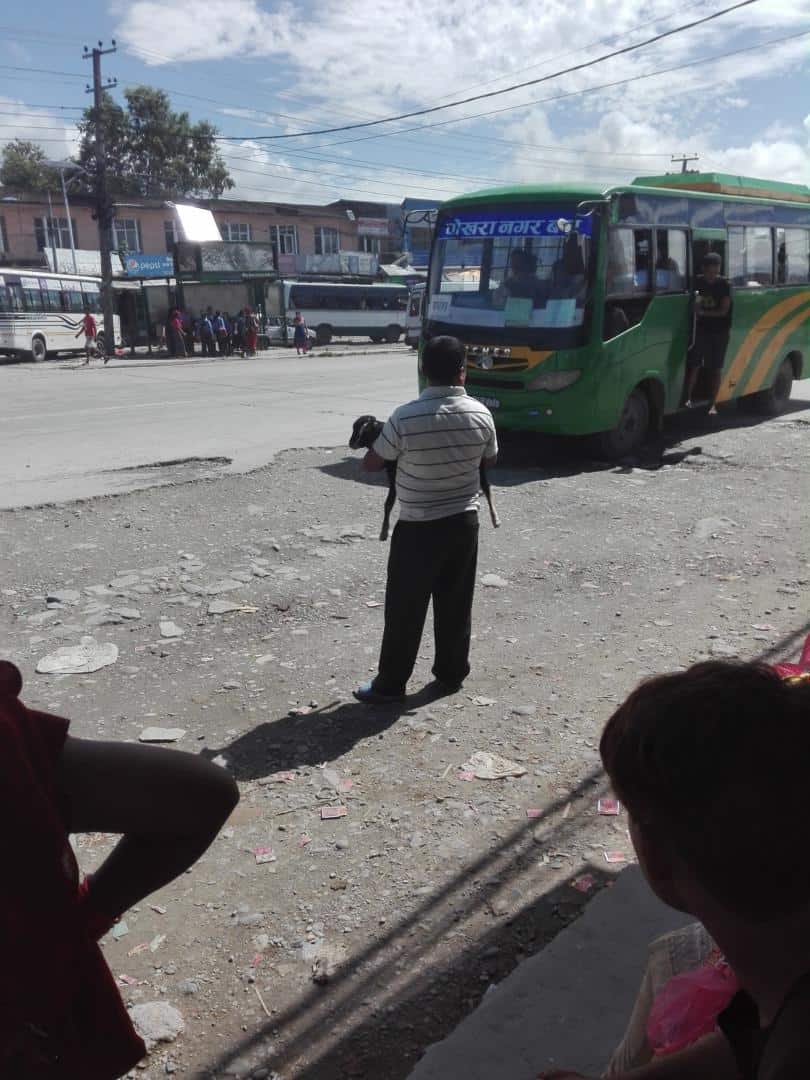
The Billy Goats
One of the old goats, a Billy of scrawny and unimpressive physical proportions but whose chin-whiskers were truly world class (I could really see why they named it a “goatee,”) was having trouble dealing with said lurches and every time the bus moved any direction but forward, lost his everlovin’ mind.
He bleated and farted and bit at the air, he tried to snarl but failed, he cried and whooped and pouted like a teenager, he screamed like a toddler and got the vapors like an old woman in a silent comedy.
I was loving the adventure of this, the wildness, the realness. This was why I came to Nepal. Not for the huge mountains, but for the little bus rides.
“How much for the goat?” I ask, over the roar of the engine. It sounds as phlegmatic as the coat. I repeated myself, which caused him to point at a sign that presumably said, “no talking to the driver.”
In lieu of a seat, I grabbed one of the overhead handles and hoped my deodorant wouldn’t fail me. Unlike most of neighboring India, Nepal is pretty temperate most of the year, but still, my pits were exposed to my fellow passengers and I hoped my shirt laundry was on point.
A Dash of Adventure
More people piled on and soon everybody and everything was squeezed together closer than a Japanese subway car at rush hour. Or maybe a Japanese subway car is as crowded as a Nepalese bus; like everything, I suppose it depends on your position.
Isn’t that why we travel? To change our position in the world, if only for the length of a holiday? And isn’t that why a dash of adventure is vital and necessary, to break us out of the rut of doing the same thing on every trip, to wrest us free from the guidebook and the online recommendations?
I was determined to see this through, no matter how silly. I checked my translation and tried again, this time asking the herder herself.

“How Much for the goat?”
“How much for the goat?” I asked in something that could not have resembled Nepali. Maybe she was born in India and spoke Hindi. I knew zero words in Hindi, which is only four less than I knew in Nepali.
To my surprise, she responded. In English; how thoughtful!
“One thousand Rupees.”
“How much is that?” I wondered, my ability to do the advanced math required for currency conversions suddenly compromised by the jostling of the bus. Whenever it hit Prithivi Highway’s infamous potholes, which was all the time- the highway is more pothole than road- you go up and down and up again like you are on a rollercoaster.
Nepal is an amusement park.
She did not look like she was enjoying the rollercoaster ride. She looked like she just wanted to get to work with all her animals unbothered.
I just wanted to get to the bank. I was going paragliding the next day and needed to pay the tour agency that was arranging my flight. And I couldn’t wait to feel the wind in my hair; I knew it was going to blow about and make me look like Fabio or at least the bassist from a Poison video. This whole endeavor was being filmed from two angles by a pair of Go-Pro cameras, and I needed my coiffure to look stunning.
Adventure Seeking and Seeing
We moved to Pokhara for adventure travel like this; mountain trekking, mainly, but everything else the city offers to adrenaline-fuelled, outdoorsy folks on the days that they aren’t out hiking in the Himalayas.
I have two children. My daughter is in her mid-teens and my son is in his mid-crazies. For those of you who don’t have a degree in pediatric medicine, “mid-crazies” is the technical and scientific term for being two years old.
They moved with me to Nepal for the summer to be with me while I wrote. My daughter came because she is curious and kind, my son because he can barely operate the chainsaw by himself. The winter is coming; he’d need a lot of wood for the fire.
One of the most popular things for people looking for another once-in-a-lifetime experience while on their trekking adventure is paragliding. These gliders look like parachutes but are really lightweight, free-flying, foot-launched aircrafts with no rigid primary structure, according to a writer with much greater knowledge of aviation than mine. The pilot and the passenger (in this case, me!) sit in a harness suspended below a fabric wing. It sounds impossible and glorious.
Paragliding Nepal
The pilots call it “flying.”
As in, “are you going flying tomorrow?” or “wow, not a cloud in the sky, this is great weather for flying.”
But the paragliding rig isn’t powered, it is just engineered to catch as much air as possible and hold it as long as it can. So, by an aviator’s definition, you aren’t really flying so much as taking advantage of a controlled fall, gliding and then catching an updraft of warm air and riding that thermal back to your starting height, then slowly falling again, as wild and free as pollen in the breeze.
Accompanied by a trained and skilled pilot, I am jumping off the side of Sagarmartha Mountain and flying over the Himalayan foothills, the surrounding rice paddies, Phewa lake, and the picaresque city of Pokhara.
I have paid for the longest flight possible. I figure that the launch and especially the landing are going to be the most frightening parts, so once I’m in the air, I want to spend as much time up there as the glider will allow.
Turns out, that is a good long time. Flights can last many hours, although I am only up for just about seventy minutes. Seventy minutes free from earth, unbound by gravity and gloom, seventy minutes to wonder about things more mystical than everyday thought usually allows.
Back to the Bus…
Gotta get to the bank. Now there’s an everyday thought.
I’ve been begging my daughter to fly with me but so far, my efforts have been futile.
At fifteen, she has none of the devil-may-care recklessness that her brother has had since the crib, nor any of the machismo of boys her age. She does not think she is invincible, she does not take chances to impress her crushes, she does not get ridiculous haircuts and strut around like a rooster. That last one isn’t limited to teenage boys, I did it last week.
And she does not fly.
My son has no such inhibitions. He would jump off a different mountain every day if you let him, without a pilot or a parachute, wearing only a pair of those shoes that squeak when you walk. I can hear it now. “Squeak squeak squeak” and then silence as he leaps into the grey and gloaming void.
Needless to say, my son is not coming to the mountain with me. He does not even know I’m going paragliding. Really, he doesn’t know much about the world. He knows that I am for wrestling, he knows his mom is for cuddling, and he knows his sister is for impressing.
She does not impress easily.
The Views
The opportunity to view Pokhara and the lake and the mountains from the sky does not impress her. My invitations for Baskin Robbins and KFC afterward do not impress her, and usually fast food is like treasure to her. Even teens who didn’t grow up in the West still want to taste it, now and then. YouTube on her phone, however, is terribly impressive, so she stares at her phone.
So, I fly alone.
Adventure is in the heart of the adventurer. If you are fifteen years old, facing the day is crazy enough; if you are two years old, nothing in the day will be crazy enough. I try not to fight against this knowledge but rarely succeed.
“Who are you to judge your kids’ lives?” I remind myself. “You bought a goat on the bus today.
Yes, I bought it.
Turns out that when I asked, “how much for the goat?” she took me quite literally. It was my fault, I was clearly not asking “how much for the goat to ride the bus?” I was only saying, “how much for the goat,” which can be interpreted in many ways.
In this case, the overworked goatherd was telling me how much to purchase the animal.
Jam Bone
Turns out, a thousand Nepali Rupees is ten bucks. Not wanting to uphold the stereotype of rude Americans, I passed it over to her right before I got off the bus, holding the leash I’d fashioned from my belt and walking him up my driveway like being a goatherd was a second job for me, like it was the most natural thing in the world.
My daughter was impressed by the goat. She has named him Jam Bone. Teenagers operate with a mysterious internal logic. I said she could keep it if she came flying with me. She declined. He now lives and bleats with the rice farmers behind our house.
I don’t know if I will have as much fun without the kids along. If the Annapurna range will seem as high or the rice paddies as verdant. I don’t know if the adventure will seem as important or as essential.
I’m sure I’ll take the bus to the launch site, most cabs here are two-seaters and there wouldn’t be enough room for both me and Jam Bone. The adventure, anyway, is in the travel.
